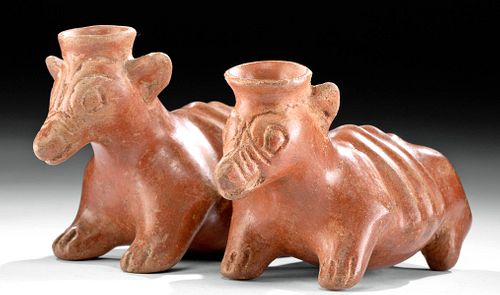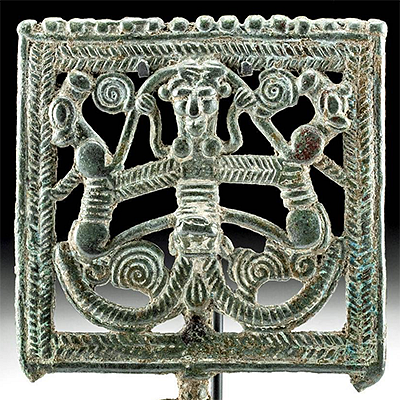Rare Colima Redware Vessel - Conjoined Dogs
Lot 77l
About Seller
Artemis Fine Arts
686 S Taylor Ave, Ste 106
Louisville, CO 80027
United States
Selling antiquities, ancient and ethnographic art online since 1993, Artemis Gallery specializes in Classical Antiquities (Egyptian, Greek, Roman, Near Eastern), Asian, Pre-Columbian, African / Tribal / Oceanographic art. Our extensive inventory includes pottery, stone, metal, wood, glass and textil...Read more
Estimate:
$3,500 - $5,000
Absentee vs Live bid
Two ways to bid:
- Leave a max absentee bid and the platform will bid on your behalf up to your maximum bid during the live auction.
- Bid live during the auction and your bids will be submitted real-time to the auctioneer.
Bid Increments
| Price | Bid Increment |
|---|---|
| $0 | $25 |
| $300 | $50 |
| $1,000 | $100 |
| $2,000 | $250 |
| $5,000 | $500 |
| $10,000 | $1,000 |
| $20,000 | $2,500 |
| $50,000 | $5,000 |
| $100,000 | $10,000 |
| $200,000 | $20,000 |
About Auction
By Artemis Fine Arts
Nov 5, 2020
Set Reminder
2020-11-05 10:00:00
2020-11-05 10:00:00
America/New_York
Bidsquare
Bidsquare : Ancient & Ethnographic From Around the World
https://www.bidsquare.com/auctions/artemis-gallery/ancient-ethnographic-from-around-the-world-5916
Ancient art from Egypt, Greece, Italy and the Near East, as well as Asian, Pre-Columbian, Native American, African / Tribal / Oceanic, Spanish Colonial, Russian Icons, Fine art, much more! All categories, all price ranges... all legally acquired and guaranteed to be as described or your money back. Artemis Fine Arts info@artemisfinearts.com
Ancient art from Egypt, Greece, Italy and the Near East, as well as Asian, Pre-Columbian, Native American, African / Tribal / Oceanic, Spanish Colonial, Russian Icons, Fine art, much more! All categories, all price ranges... all legally acquired and guaranteed to be as described or your money back. Artemis Fine Arts info@artemisfinearts.com
- Lot Description
Pre-Columbian, West Mexico, Colima, Protoclassic period, ca. 100 BCE to 250 CE. A hand-built redware pottery sculpture of an incredibly rare form composed of two emaciated canines that are conjoined at the belly. Each dog stands atop a quartet of attenuated legs, as a perky tail, and presents ribs, hip, and spinal bones from beneath the malnourished skin. The raised heads are decorated with several incised striations that surround the discoid eyes and tapered snouts, and a pair of tab-shaped ears flank the flared spout rim atop the head. The attachment between the abdomens illustrates how each dog was formed separately then conjoined and thus explains the lack of a mutual gap between the chambers that would have effectively made the two bellies into one contiguous vessel. Size: 7.25" L x 6.3" W x 4.125" H (18.4 cm x 16 cm x 10.5 cm)
Scholars know of at least two types of Colima dogs, one to be fattened up and ritually sacrificed or eaten and one to serve as a watchdog and healer of the ill. This plump hairless canine known as a Chichi or Escuintla is thought to be related to the Chihuahua or Mexican Hairless also known as the Xoloitzcuintle. The Xolo dog was named for the deity Xolotl, the God of the Underworld, and believed to guide the deceased as they journeyed to the afterlife. Colima vessels such as this one were buried in shaft tombs to protect the deceased and provide sustenance for eternity.
A stylistically similar example of a singular dog, of a monumental size and with incredible incised details, hammered for $37,500 at Bonhams, New York "African, Oceanic and Pre-Columbian Art" auction (November 14, 2013, lot 7).
Provenance: ex-Barakat Gallery, Beverly Hills, California, USA, acquired prior to 2000
All items legal to buy/sell under U.S. Statute covering cultural patrimony Code 2600, CHAPTER 14, and are guaranteed to be as described or your money back.
A Certificate of Authenticity will accompany all winning bids.
We ship worldwide and handle all shipping in-house for your convenience.
#153770Repair to hind quarters of dog with a tail, spout of dog without a tail, and abdominal joint, with resurfacing and overpainting along break lines on dogs, and adhesive residue along central joint. Loss to tail of one dog as shown. Minor abrasions and nicks to spouts, bodies, legs, and joint, with light softening to some incised facial details, and minor fading to areas of original pigmentation. Light earthen deposits, nice mineral deposits, and great remains of original pigment throughout.Condition
- Shipping Info
-
All shipping is handled in-house for your convenience. Your invoice from Artemis Gallery will include shipping calculation instructions. If in doubt, please inquire BEFORE bidding for estimated shipping costs for individual items.
-
- Buyer's Premium



 EUR
EUR CAD
CAD AUD
AUD GBP
GBP MXN
MXN HKD
HKD CNY
CNY MYR
MYR SEK
SEK SGD
SGD CHF
CHF THB
THB












